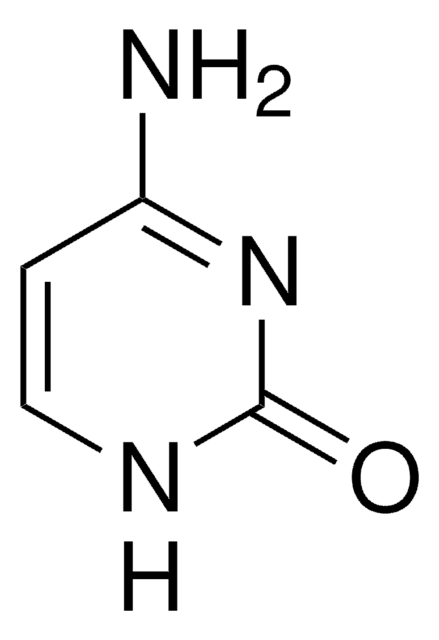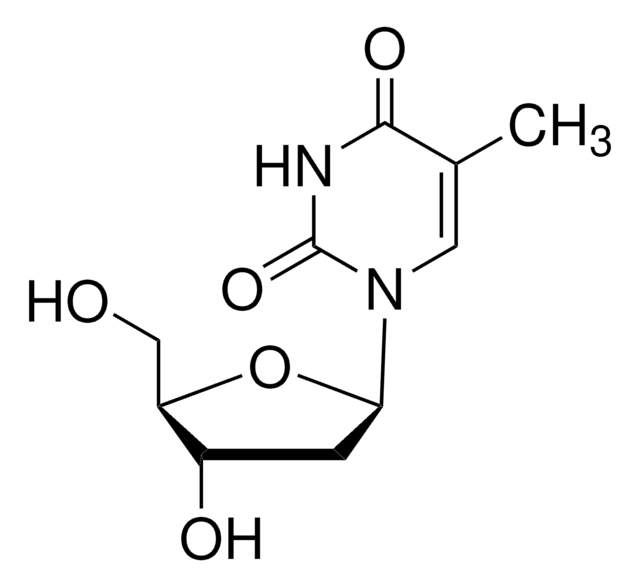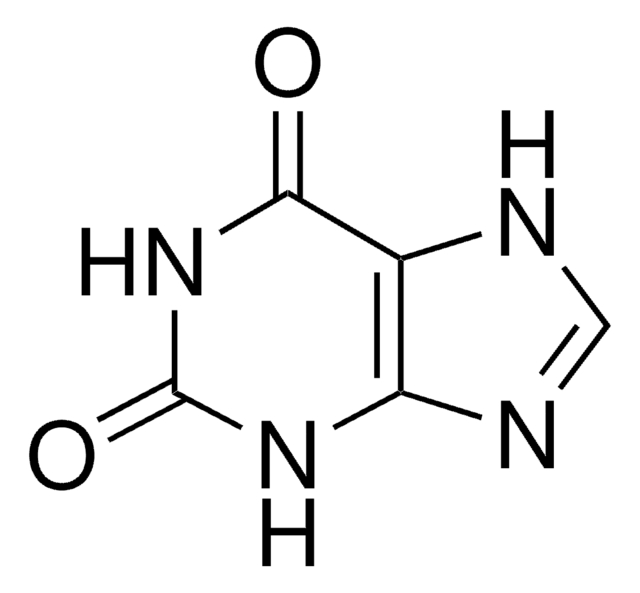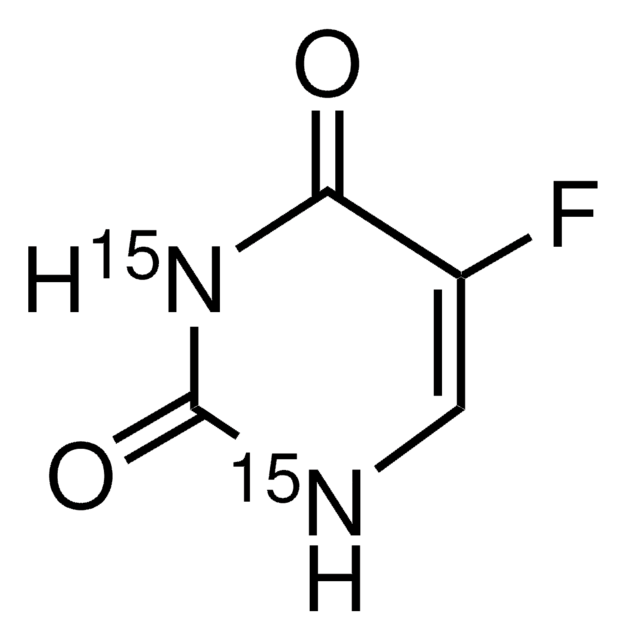Wszystkie zdjęcia(1)
Kluczowe dokumenty
T0376
Thymine
≥99%
Synonim(y):
2,4-Dihydroxy-5-methylpyrimidine, 5-Methyluracil
Zaloguj sięWyświetlanie cen organizacyjnych i kontraktowych
About This Item
Wzór empiryczny (zapis Hilla):
C5H6N2O2
Numer CAS:
Masa cząsteczkowa:
126.11
Beilstein:
117880
Numer WE:
Numer MDL:
Kod UNSPSC:
41106305
Identyfikator substancji w PubChem:
NACRES:
NA.51
Polecane produkty
pochodzenie biologiczne
synthetic (organic)
Poziom jakości
Próba
≥99%
Formularz
powder
mp
~320 °C (dec.) (lit.)
ciąg SMILES
CC1=CNC(=O)NC1=O
InChI
1S/C5H6N2O2/c1-3-2-6-5(9)7-4(3)8/h2H,1H3,(H2,6,7,8,9)
Klucz InChI
RWQNBRDOKXIBIV-UHFFFAOYSA-N
informacje o genach
mouse ... Tymp(72962)
Szukasz podobnych produktów? Odwiedź Przewodnik dotyczący porównywania produktów
Opis ogólny
Thymine is one of the four nucleobases, along with adenine, guanine and cytosine found in deoxyribonucleic acids (DNA).
Zastosowanie
Thymine has been used as a standard nitrogenous base in high-performance liquid chromatography-ultraviolet (HPLC-UV) for the quantification of bone DNA samples, Raman scattering experiments. It has also been used as supplement in C2C12 myoblast cells. Thymine may be used to study chemical processes that affect DNA structure, such a radiation induced radical production leading to base cross-linking reactions and derivitizations. It may be used to study the parameters of hydrogen bonding kinetics and energies with other nucleobases such as adenine.Thymine is used to develop sensitive heavy metal (mercury) detectors based on coordination chemistry and nanoparticle structures.
Działania biochem./fizjol.
Thymine used in studying DNA structure byirradtaion methods leading to cross-linking reactions and derivitizations. Thymine dimers are indicative of DNA damage. Thymine is used with metal (mercury) to form thymine−HgII−thymine (T−HgII−T) duplexes. Thymine starvation in bacteria leads to halt in DNA synthesis and is referred as thymine-less death.
Ta strona może zawierać tekst przetłumaczony maszynowo.
Kod klasy składowania
11 - Combustible Solids
Klasa zagrożenia wodnego (WGK)
WGK 3
Temperatura zapłonu (°F)
Not applicable
Temperatura zapłonu (°C)
Not applicable
Środki ochrony indywidualnej
Eyeshields, Gloves, type N95 (US)
Wybierz jedną z najnowszych wersji:
Masz już ten produkt?
Dokumenty związane z niedawno zakupionymi produktami zostały zamieszczone w Bibliotece dokumentów.
Klienci oglądali również te produkty
Methods for detection of cytosine and thymine modifications in DNA
Berney M and McGouran JF
Nature Reviews Chemistry, 1-1 (2018)
On How Watson and Crick Discovered what Watson and Crick had Suggested: The" Folk" Concept of Discovery Rediscovered
Charpa U
History and philosophy of the life sciences, 7-30 (2008)
Andrej Dementjev et al.
Scientific reports, 10(1), 17097-17097 (2020-10-15)
Identification of chemically homologous microcrystals in a polycrystal sample is a big challenge and requires developing specific highly sensitive tools. Second harmonic (SHG) and coherent anti-Stokes Raman scattering (CARS) spectroscopy can be used to reveal arrangement of thymine molecules, one
MercuryII-mediated formation of thymine- HgII- thymine base pairs in DNA duplexes
Miyake Y, et al.
Journal of the American Chemical Society, 128(7), 2172-2173 (2006)
Yang-Wei Lin et al.
The Analyst, 136(5), 863-871 (2010-12-16)
Monitoring the levels of potentially toxic metal (PTM) ions (e.g., Hg(2+), Pb(2+), Cu(2+)) in aquatic ecosystems is important because these ions can have severe effects on human health and the environment. Gold (Au) nanomaterials are attractive sensing materials because of
Nasz zespół naukowców ma doświadczenie we wszystkich obszarach badań, w tym w naukach przyrodniczych, materiałoznawstwie, syntezie chemicznej, chromatografii, analityce i wielu innych dziedzinach.
Skontaktuj się z zespołem ds. pomocy technicznej







